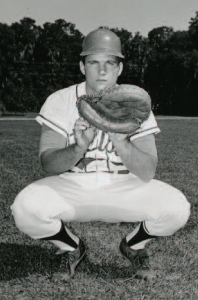
Currently standing eighth in all-time wins among active coaches, Pete Dunn's Stetson teams have racked up 1,167 victories under his guidance. Over the tenure, he's sent 72 players on to the professional ranks, taken the Hatters to 16 NCAA Regional Tournament appearances, won eight Atlantic Sun Conference titles and has been named league coach of the year a record six times.
In addition to his collection of accolades, which includes a "Pete Dunn Day" (February 9) in the city of DeLand, Fl., Dunn is regarded as one of the premier catching coaches in the country, having authored a chapter on catching in
The Baseball Drill Book.
Inside Pitch recently asked Dunn to explain just how much the catching position has changed over the years:
Inside Pitch: How has the position changed in terms of body type, athleticism, and from an offensive standpoint?
Pete Dunn: "You look back in the old days when I was playing, catchers were the 'squatty-body' guys back there. If they couldn't run or couldn't field, you just stuck 'em behind the plate. That's not the way it is anymore, I mean, just look at guys like Yadier Molina. They're just so darn athletic.
In the past if you could really catch, you could catch in the big leagues, whether you could hit or not. That's changed too. Not only are catchers much more athletic, it's more of an offensive position as well. It's not a place you stick a guy that can't do anything else, like the way it used to be. I think that if you're going to have a championship club, you'd better have a guy like that back there."
IP: What do you think about calling pitches from the dugout versus letting your catchers do it?
PD: At the college level, catchers calling games is in the minority now, and that’s something that,
being a former catcher, I had to get over; I loved calling the game and controlling the game when I
played. I’ve had catchers who we’ve let call pitches before, but I think with scouting reports now, it’s easier and more efficient for a coach to call pitches from the dugout.
IP: How important is it for catchers to be able to manage a pitching staff?
PD: It’s your job to know the movement that pitchers have. Some guys get more run on their fastballs, for example.
Every pitcher is different, physically, mentally and emotionally. Knowing your staff and being able to shift gears throughout the course of the game is very important.
IP: What kind of ‘tools’ do you evaluate when you are scouting and developing catchers?
PD: I think leadership is number one for me behind the plate. I’ll take a guy who can really lead and run the game back there over a guy that might have the best arm strength or whatever. Arm strength is the most visible thing you look for, but I love to see a catcher who does everything so effortlessly in terms of receiving. It makes the pitcher look good and umpires like to call games behind them.
Receiving, soft hands, subtle body movement and shifting while receiving and blocking are also things I look for when I go see a catcher. Obviously you want to see a kid be quick and block balls. I hate passed balls. I get on my catchers for passed balls more than anything else. Once in a while you get crossed up and we understand that, but for the most part, passed balls are a lack of concentration and a lack of focus. That’s why the position is called “catcher” – not “fetcher!” IP